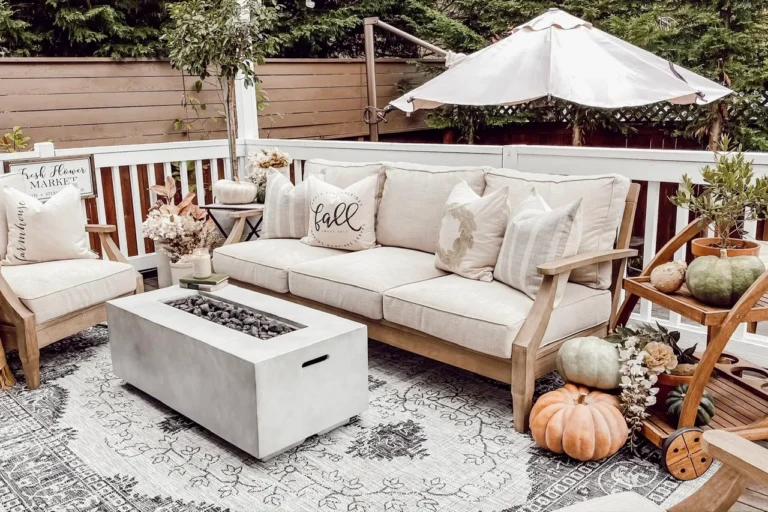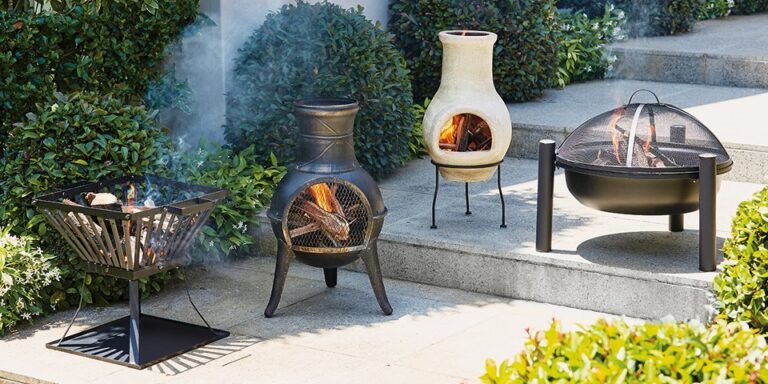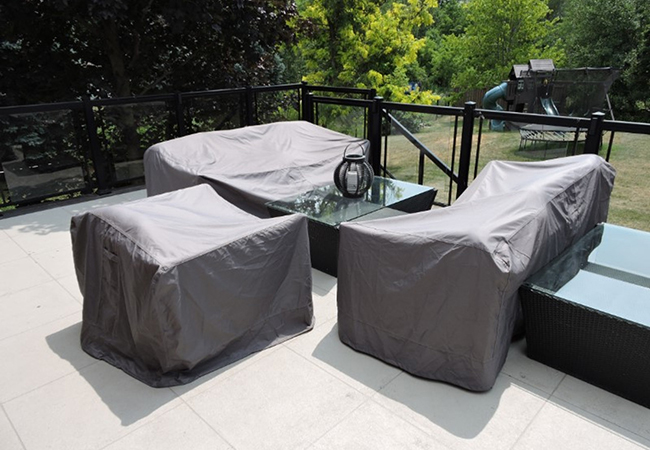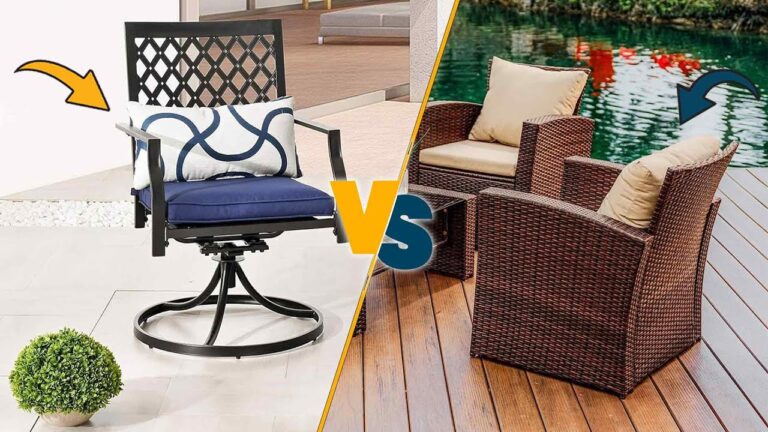Polywood vs Other Outdoor Furniture Materials: A Comprehensive Comparison
When it comes to creating an inviting outdoor space, choosing the right furniture is key. But with so many materials on the market, it can be tough to decide which one is best for your patio.
Polywood has emerged as a popular choice due to its durability, low maintenance, and environmental benefits, but how does it compare to other common materials like Teak, Metal, and Wicker?
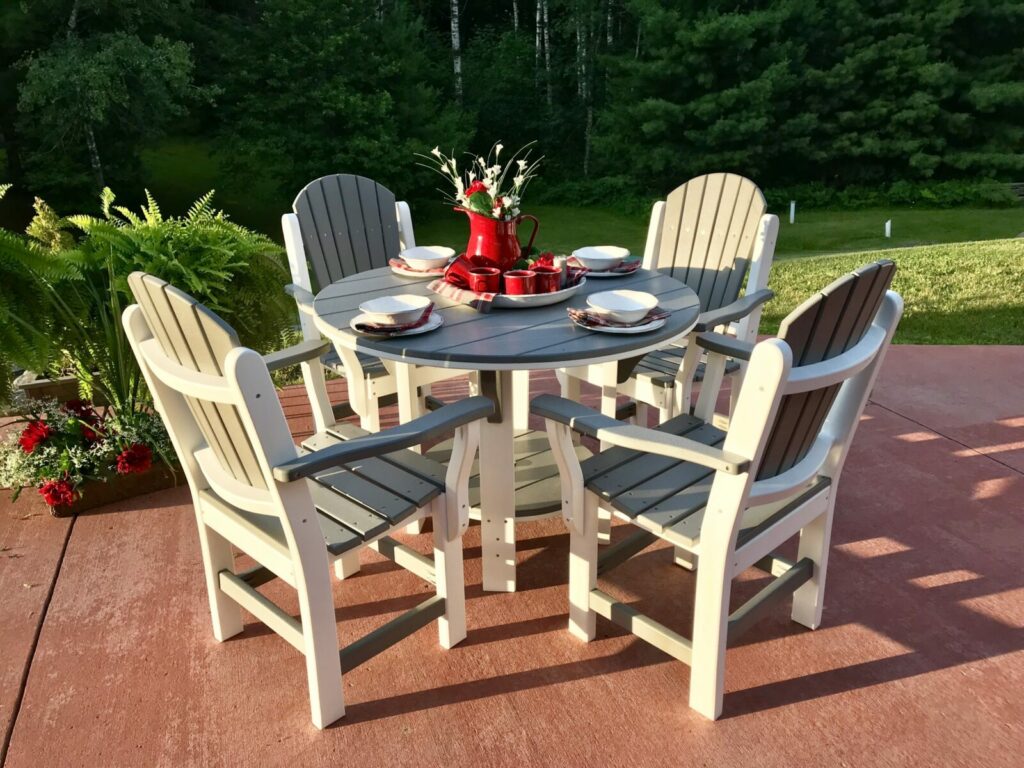
In this comprehensive guide about Polywood vs Other Outdoor Furniture Materials, I’ll break down the pros and cons of each material, helping you make an informed decision for your outdoor living area.
Polywood vs. Teak: Which is Better for Your Patio?
Teak and Polywood are both known for their exceptional durability, making them top choices for outdoor furniture. However, they offer very different experiences in terms of maintenance, aesthetics, and cost.
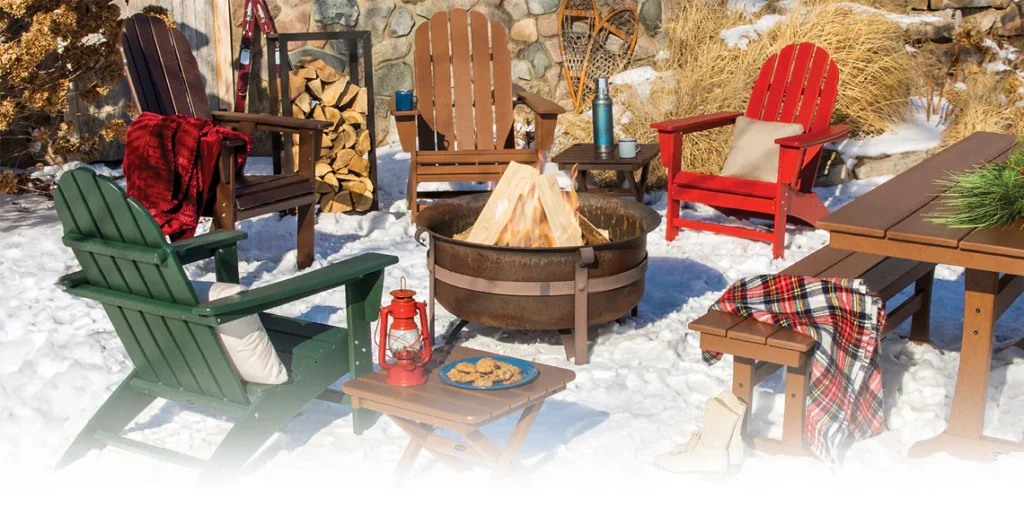
Longevity and Durability Comparison
Teak is often hailed as the gold standard in outdoor furniture materials, and for good reason. This dense, tropical hardwood is naturally resistant to moisture, insects, and rot, which makes it incredibly durable. Teak’s high oil content allows it to withstand harsh weather conditions, from blistering sun to torrential rain, without warping or cracking.
Many teak furniture pieces have been known to last 50 years or more, which is a testament to their durability. However, this longevity comes with a high price tag, as Teak is one of the most expensive woods available.
Polywood, made from high-density polyethylene (HDPE), offers a different kind of durability. It’s a synthetic material created from recycled plastics, designed to endure the elements without fading, cracking, or splintering. Polywood is impervious to moisture, meaning it won’t rot, warp, or crack over time. It’s also UV-resistant, so it won’t fade, even after years of sun exposure. While Polywood might not have the same natural appeal as Teak, it makes up for it with resilience and an eco-friendly pedigree. And though Polywood furniture doesn’t last quite as long as Teak, with proper care, you can still expect it to hold up beautifully for decades.
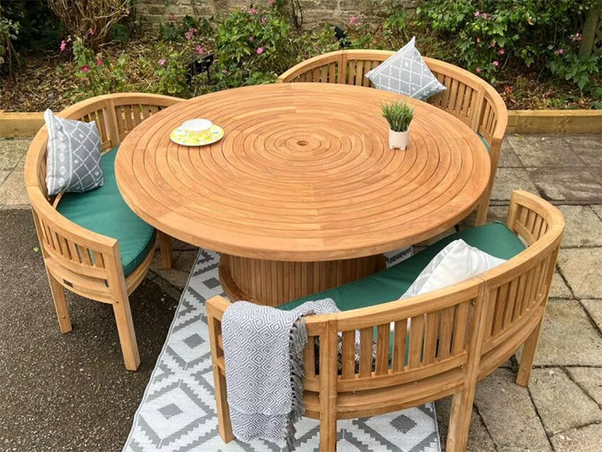
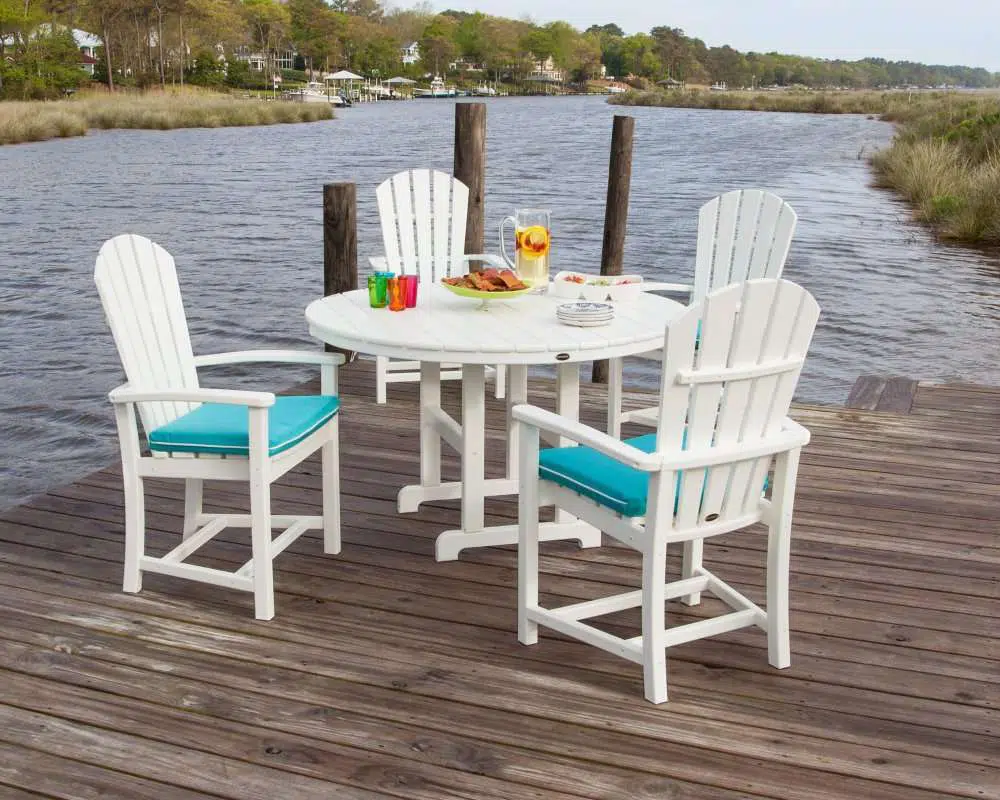
Maintenance Requirements and Costs
Maintaining Teak furniture is a bit of a labor of love. If left untreated, Teak will gradually weather to a silvery-gray patina, which some people find attractive. However, if you prefer to retain Teak’s original golden-brown hue, regular maintenance is required. You’ll need to clean the furniture periodically and apply Teak oil or sealer to protect the wood and preserve its color. This upkeep can be time-consuming and adds to the overall cost of owning Teak furniture.
Polywood, by contrast, is virtually maintenance-free. It doesn’t require painting, staining, or sealing, and it’s resistant to common issues like cracking, chipping, and moisture damage. Cleaning Polywood furniture is as simple as wiping it down with soap and water. This low-maintenance aspect makes Polywood an attractive option for those who want to spend more time enjoying their outdoor space and less time maintaining it.
Environmental Impact
Another significant factor to consider is the environmental impact of each material. Teak, while a natural and renewable resource, is often harvested from old-growth forests, which raises concerns about deforestation and sustainability. However, some Teak furniture is made from responsibly sourced, certified sustainable wood, which helps mitigate this impact.
Polywood, on the other hand, is made from recycled plastics, primarily milk jugs and detergent bottles. This not only diverts plastic waste from landfills but also reduces the demand for virgin plastic production. Polywood is an excellent choice for eco-conscious consumers looking to reduce their environmental footprint.
Polywood vs. Metal: Which One Should You Choose?
Metal furniture is a popular choice for outdoor spaces, offering strength and a sleek, modern aesthetic. But how does it compare to Polywood in terms of comfort, durability, and style?
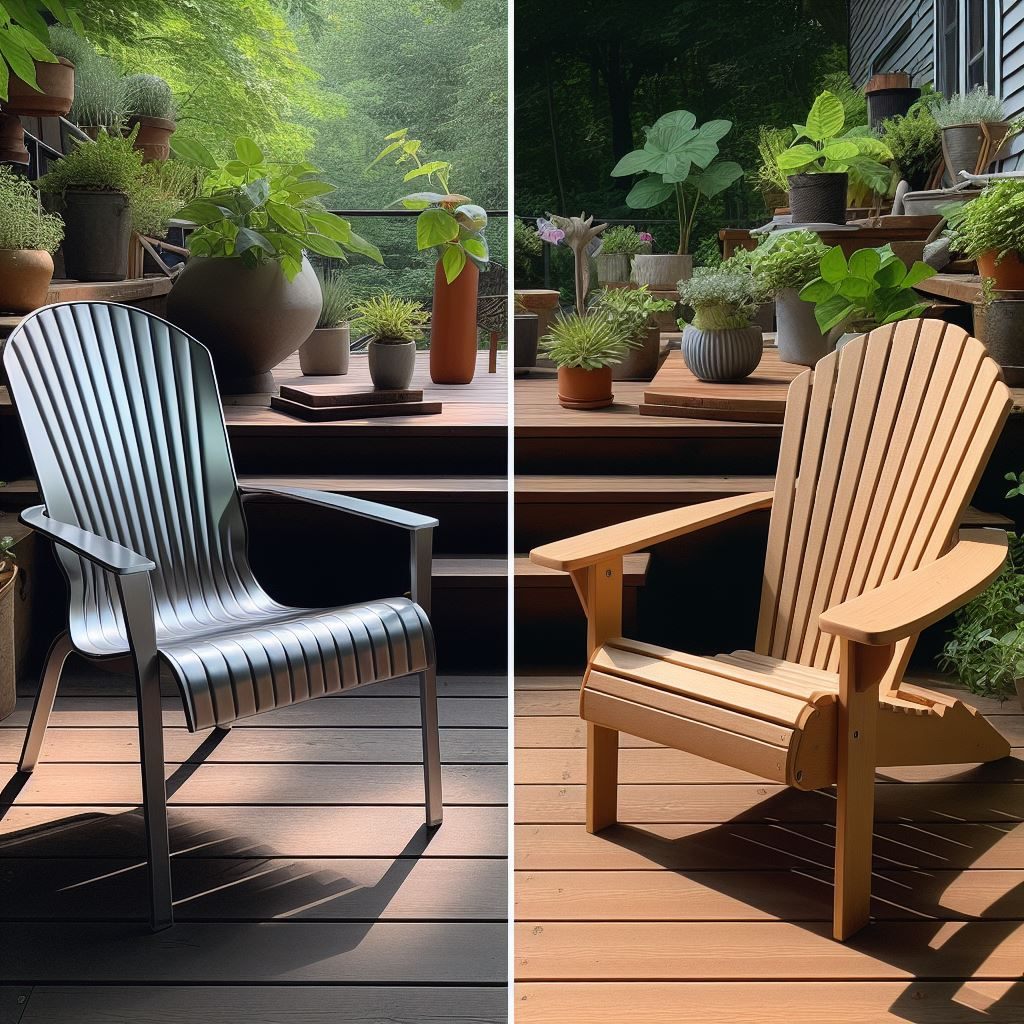
Pros and Cons of Polywood and Metal Furniture
Metal outdoor furniture comes in several forms, including aluminum, steel, and wrought iron. Each has its own set of advantages and drawbacks:
Aluminum: This is a lightweight, rust-resistant metal that’s easy to move around and can be left outdoors year-round. However, it can be easily dented or scratched and may not provide the same level of sturdiness as other materials.
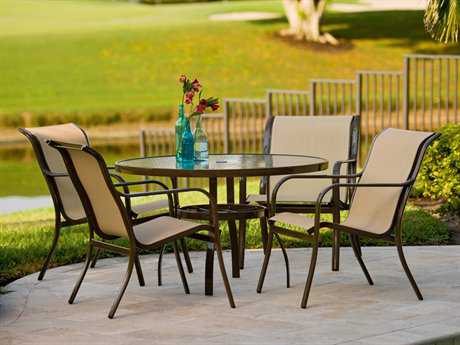
Steel: Steel furniture is extremely durable and heavier than aluminum, offering greater stability. It’s often coated with protective finishes to prevent rust, but over time, it can still be susceptible to corrosion, especially in coastal environments.

Wrought Iron: Known for its classic and ornate designs, wrought iron is the heaviest and most durable of the metal options. However, it requires regular maintenance to prevent rust and can be uncomfortable to sit on without cushions.
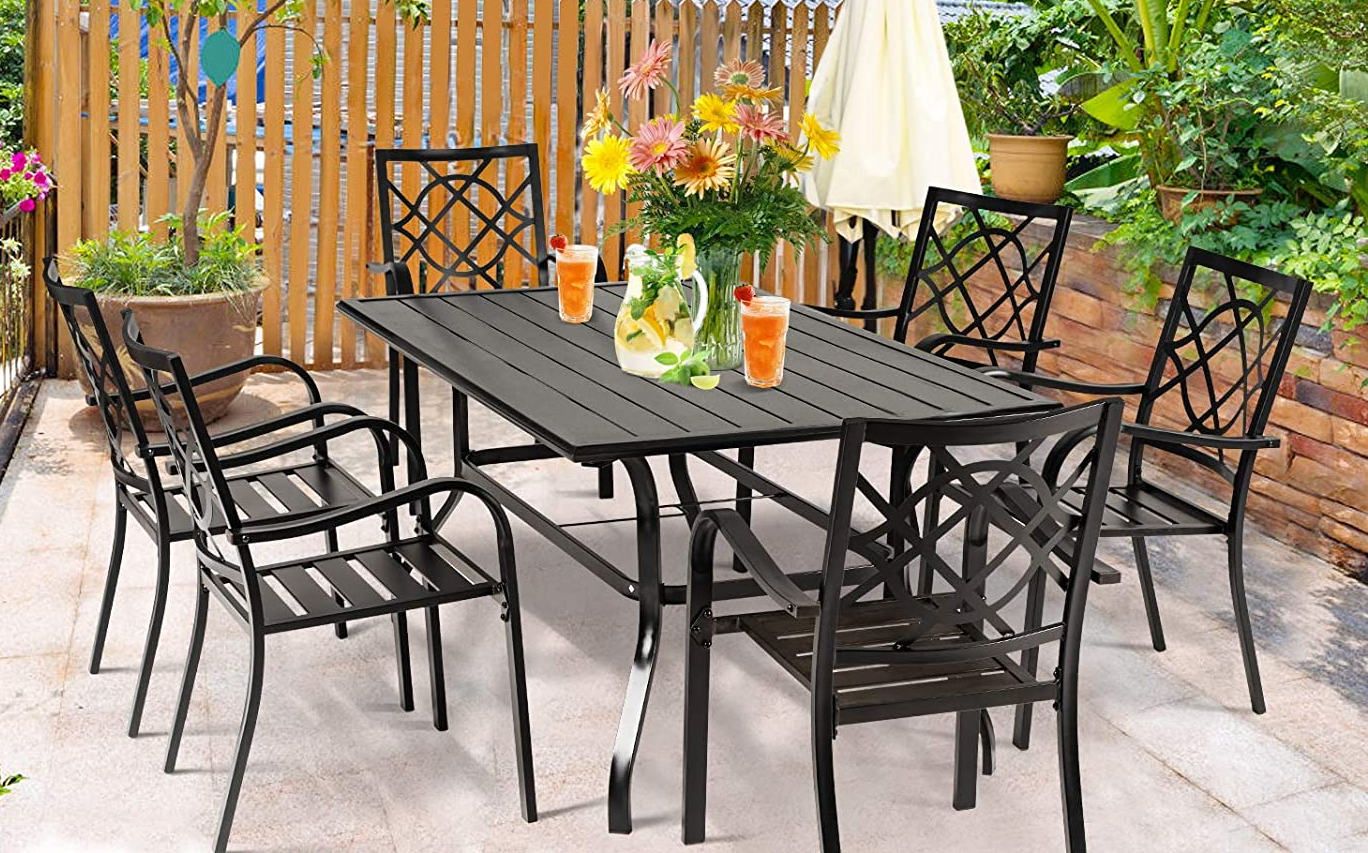
Polywood, in contrast, avoids many of the issues associated with metal furniture. It doesn’t rust, making it ideal for all-weather use, including in coastal areas where saltwater can be a concern. Polywood also remains cool to the touch, even in direct sunlight, unlike metal, which can become uncomfortably hot. The primary downside of Polywood compared to metal is that it tends to be bulkier and lacks the sleek lines that metal furniture can offer.
Best Uses for Each Material
Metal furniture shines in settings where a modern or industrial look is desired. It’s particularly well-suited for outdoor dining sets, where its strength and formality can enhance the dining experience. Metal is also a good choice for smaller spaces, as its thinner frames take up less visual space, making a patio feel more open.
Polywood, on the other hand, is perfect for creating a comfortable, relaxed atmosphere. It’s especially popular for Adirondack chairs, garden benches, and other casual seating options. Polywood’s substantial weight also makes it a good choice for windy locations, as it won’t blow over easily.
Polywood vs. Wicker: Aesthetic and Functional Differences
Wicker furniture has been a staple of outdoor living for centuries, beloved for its natural, handcrafted look and lightweight feel. But how does wicker stack up against the modern, durable Polywood?
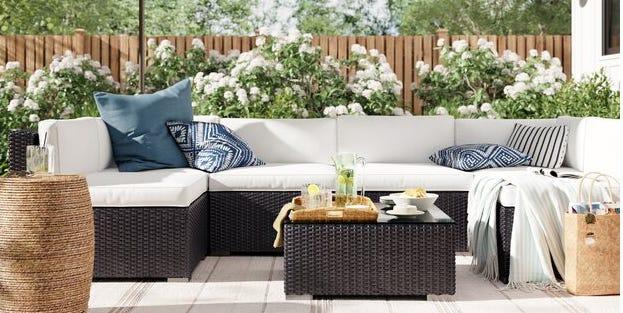
Style and Design Versatility
Wicker furniture, traditionally made from rattan or similar materials, offers a charming, rustic appeal that fits well in a variety of outdoor settings. Its woven texture adds visual interest and can create a cozy, inviting atmosphere. Today, many wicker furniture pieces are made from synthetic materials, like resin, which offer improved durability while maintaining the classic look of natural wicker.
Polywood, while not as intricate in design, offers its own versatility. Available in a wide range of colors, from traditional wood tones to vibrant modern hues, Polywood can complement almost any outdoor aesthetic. Its solid construction also provides a sturdy, stable base that won’t sag or lose its shape over time, which can be an issue with some wicker furniture.
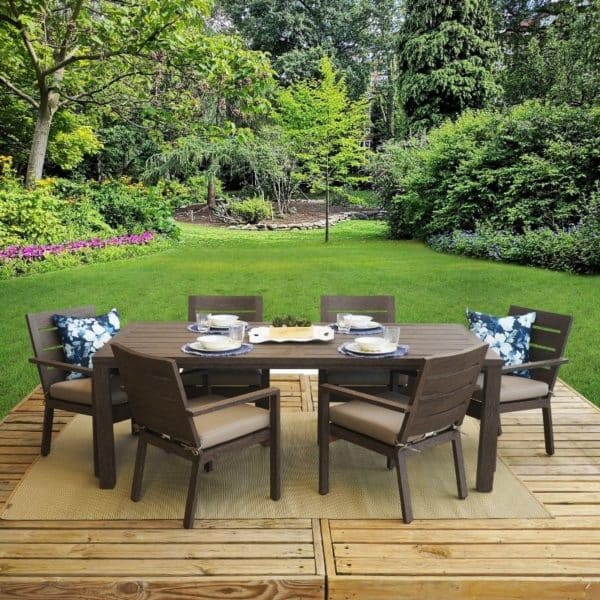
Comfort and Usability Considerations
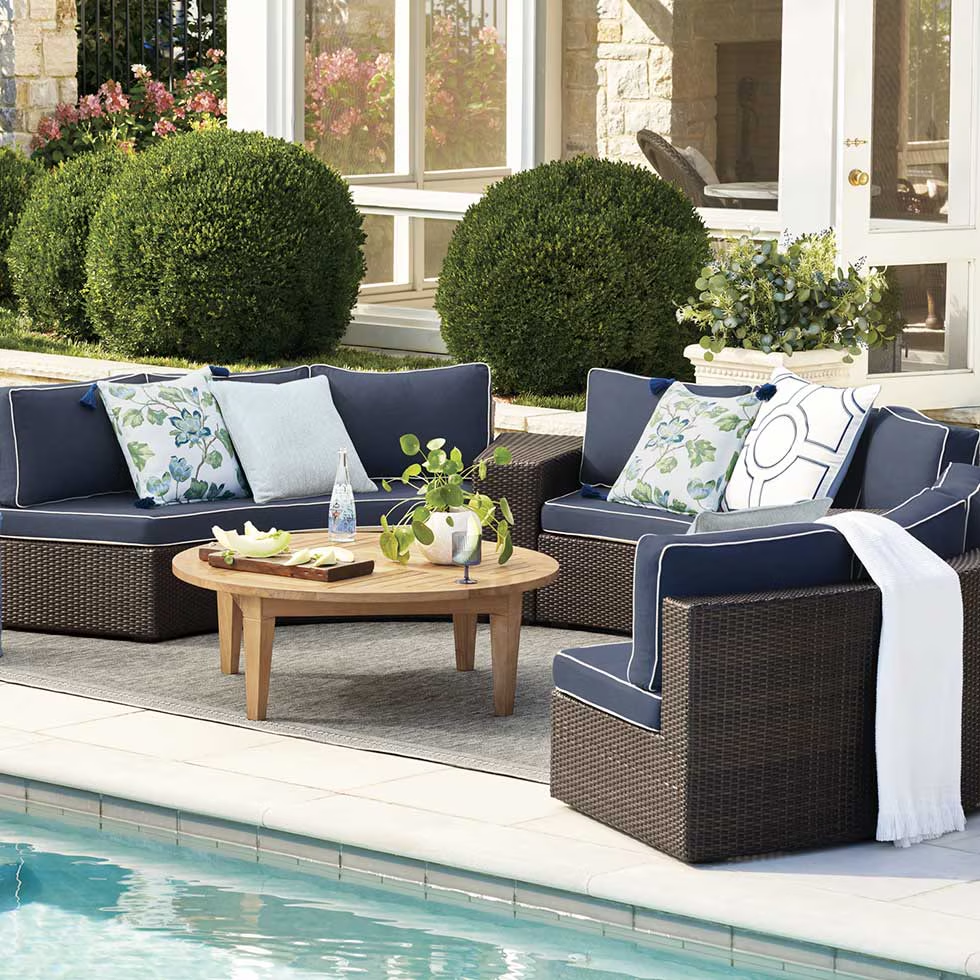
One of wicker’s biggest advantages is its comfort. The woven design of wicker furniture allows it to flex slightly, providing a comfortable, cushioned seat even without additional padding. However, natural wicker can be vulnerable to the elements. It can become brittle and break over time if exposed to moisture, making it less durable in certain climates.
Synthetic wicker, while more resilient, still doesn’t offer the same longevity as Polywood. Polywood furniture, although more rigid, can be just as comfortable when paired with cushions. It’s also impervious to weather conditions that might damage wicker, making it a more practical choice for those looking for long-lasting outdoor furniture.
Cost Considerations: Value for Your Investment
Price is often a deciding factor when choosing outdoor furniture. While quality outdoor furniture is an investment, the initial cost and long-term value can vary significantly between materials.
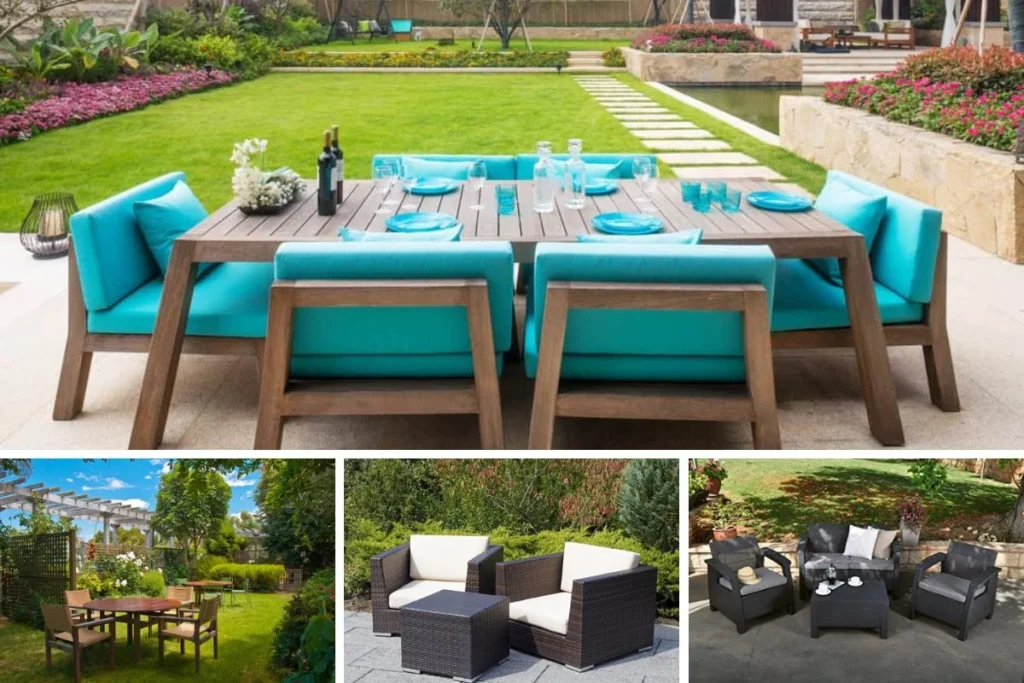
- Teak: As one of the most expensive options, Teak furniture represents a significant upfront investment. However, its longevity and timeless appeal can justify the higher price for those willing to invest in a material that will last for decades.
- Metal: The cost of metal furniture can vary widely depending on the type of metal and the quality of craftsmanship. Aluminum is typically more affordable, while wrought iron can be more expensive due to its weight and durability. However, metal furniture might require more frequent replacement or maintenance, especially if rust becomes an issue.
- Wicker: Natural wicker furniture tends to be on the lower end of the price spectrum, but it may need to be replaced more frequently due to its susceptibility to weather damage. Synthetic wicker offers a middle ground, with improved durability at a slightly higher price point.
- Polywood: Polywood is often priced competitively with mid-to-high-end outdoor furniture materials. While it may be more expensive than some metal or wicker options, its durability and low maintenance requirements often make it a better long-term investment.
Sustainability: Making an Eco-Friendly Choice
Sustainability is increasingly important for many consumers, and it’s worth considering the environmental impact of your outdoor furniture.
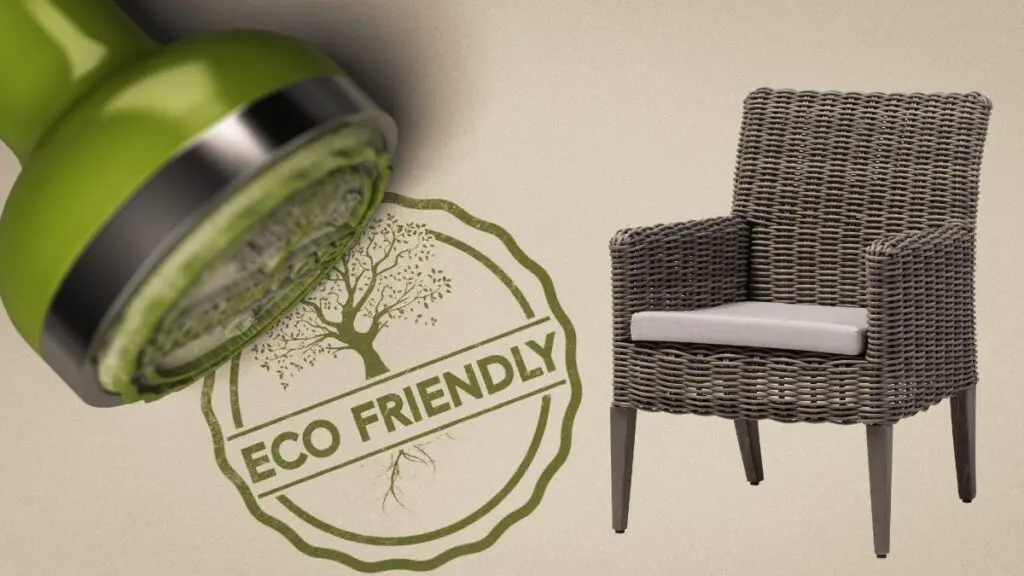
- Teak: While Teak is a natural material, its sustainability depends on the source. Teak harvested from responsibly managed plantations can be a sustainable choice, but old-growth Teak contributes to deforestation and habitat loss.
- Metal: Metal furniture is recyclable, which gives it an edge in terms of sustainability. However, the production of metal furniture, particularly steel and wrought iron, can be energy-intensive and contribute to carbon emissions.
- Wicker: Natural wicker is biodegradable, making it a relatively eco-friendly option. Synthetic wicker, while not biodegradable, can be more durable, reducing the need for frequent replacements and thus lowering its overall environmental impact.
- Polywood: Polywood stands out for its eco-friendly credentials. Made from recycled plastics
, it not only helps reduce plastic waste but also eliminates the need for virgin plastic production. Polywood furniture can be recycled at the end of its life, further contributing to a circular economy.
How to Care for Your Outdoor Furniture: Tips for Each Material
Proper care can extend the life of your outdoor furniture, regardless of the material. Here’s a quick guide on how to maintain each type:
- Teak: Clean with mild soap and water. Apply Teak oil or sealant to maintain color, or allow it to weather naturally. Avoid harsh chemicals that can damage the wood.
- Metal: Regularly clean with water and mild soap. Inspect for rust and apply rust-resistant paint or coating as needed. Store metal furniture indoors during the winter to prevent rust.
- Wicker: Clean with a soft brush and mild soap. Avoid prolonged exposure to moisture, which can cause natural wicker to weaken. Store indoors during harsh weather conditions.
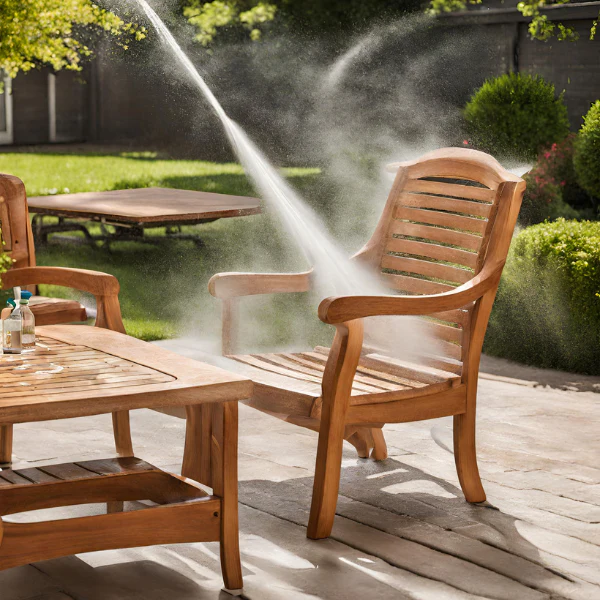
- Polywood: Clean with soap, water, and a soft brush. No need for painting, staining, or waterproofing. Polywood can be left outdoors year-round without worry.
Conclusion
Choosing the right outdoor furniture material is crucial for creating a space that’s not only beautiful but also functional and long-lasting. Polywood, with its combination of durability, low maintenance, and eco-friendly origins, stands out as a top contender for those seeking a hassle-free outdoor living experience. However, the natural beauty and longevity of Teak, the strength and modern appeal of Metal, and the classic charm of Wicker all have their own merits.
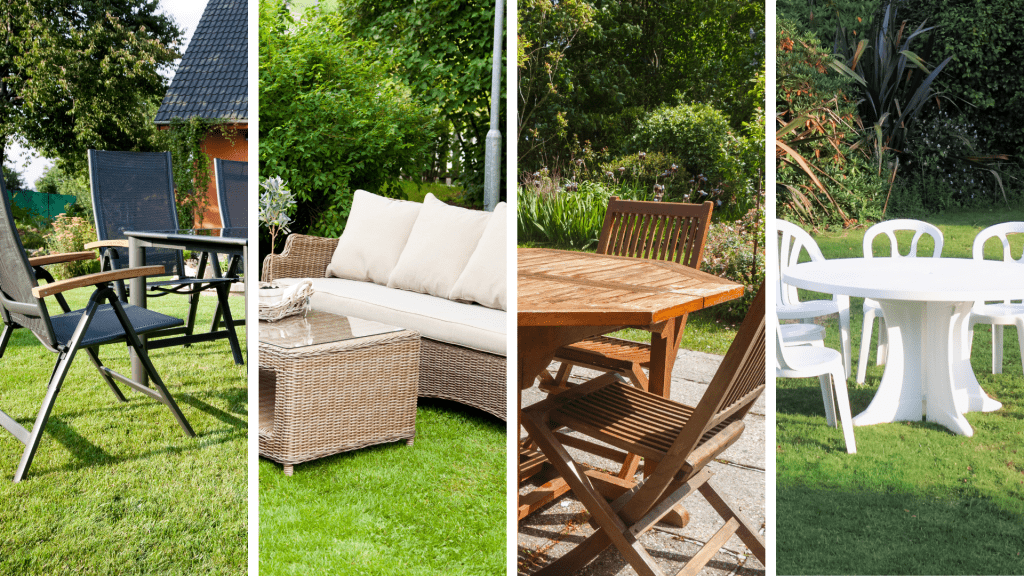
The best choice depends on your personal preferences, your climate, and how much time and effort you’re willing to put into maintaining your outdoor furniture. Whether you opt for the timeless appeal of Teak, the sturdy simplicity of Metal, the cozy charm of Wicker, or the modern resilience of Polywood, investing in quality outdoor furniture will enhance your enjoyment of your outdoor space for years to come.
Disclosure: Our blog contains affiliate links to products. We may receive a commission for purchases made through these links. However, this does not impact our reviews and comparisons. We try our best to keep things fair and balanced, in order to help you make the best choice for you.


